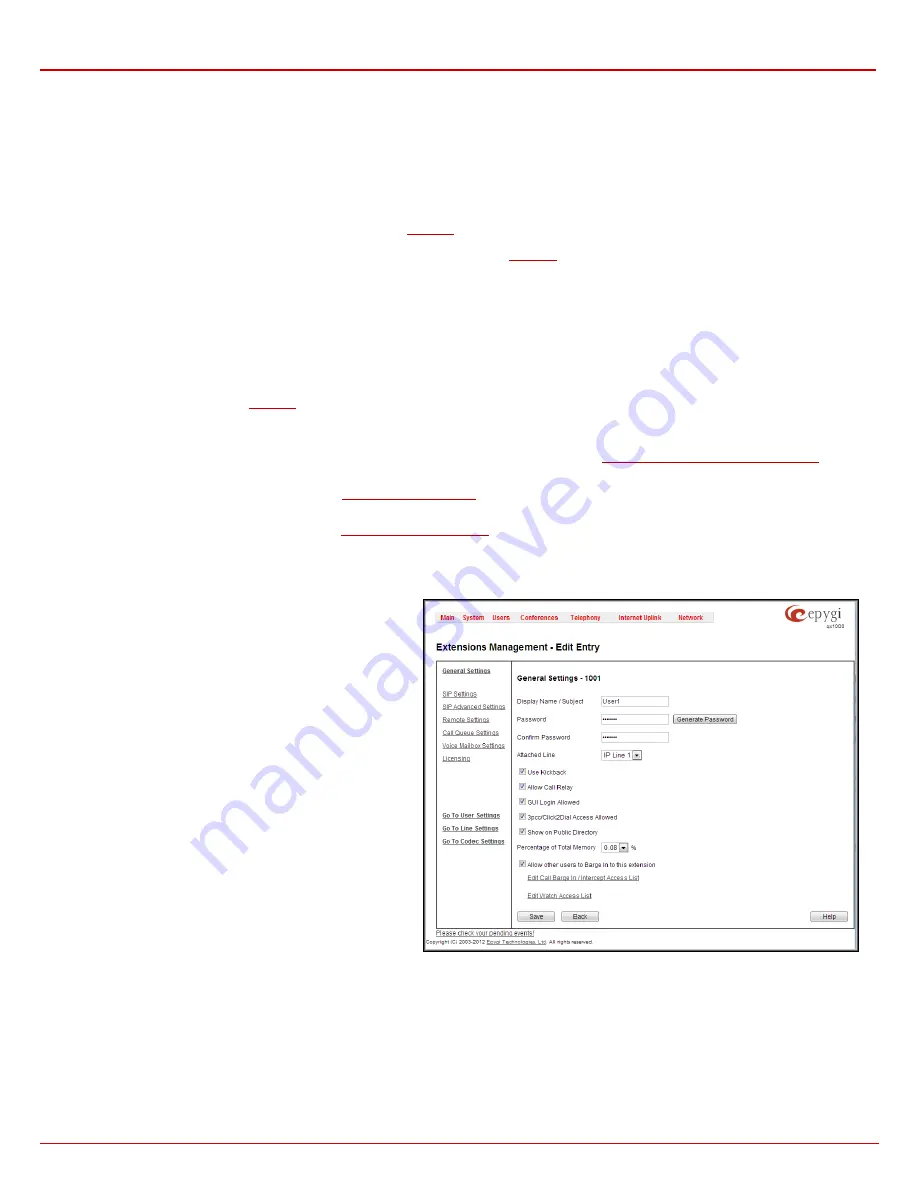
QX1000 Manual II: Administrator's Guide
Administrator’s Menus
QX1000; (SW Version 5.3.x)
43
•
Attendant ,
•
User Extension,
•
Pickup Group,
•
Call Park,
•
Paging Group,
•
ACD Group (if this feature is previously activated from
page),
•
Recording Box (if the
Call Recording
feature is previously activated from
page).
Edit
opens the
Edit Entry
page where a newly created user or attendant extension settings might be adjusted. To operate with
Edit
, one or more
record(s) have to be selected; otherwise the “No records selected” error message will appear.
The
Edit Entry
page consists of two frames. In the left frame settings groups are listed. Clicking on the corresponding settings group displays their
configuration options in the right frame.
Please Note:
Save changes before moving among settings groups.
Hide extensions attached to disabled IP lines
functional button is used to hide extensions which are attached to the disabled IP lines. When this
functional button is pressed, it transforms to
Show all extensions
functional button, which is used to show all hidden extensions. To enable the
lines, install a feature key from the
page.
Reset SIP Settings
functional button is used to reset all SIP settings of the selected extension(s) to the default values, including all settings listed
under SIP Settings and SIP Advanced Settings pages (see below).
The
Upload Universal Extension Recordings
link found at the bottom of the page leads to the
Upload Universal Extension Recordings
where universal default voice messages for all extensions can be defined.
The
Add Multiple Extensions
link leads to the
page, where multiple extensions can be added to the Extensions
Management table at once.
The
User Extension Bulk Import
link leads to the
page, where group of user-type extensions can be added/modified,
configuring their settings or modifying the configurations of group of existing extensions.
User Extension Settings
1.
General Settings
This group requires extension‘s personal information and has
the following components:
Display Name
is an optional parameter used to recognize the
caller. Usually the display name appears on the called party’s
phone display when a call is made or a voice mail is sent.
Password
requires a password for the new extension.
The extension password may only contain digits. If non-numeric
symbols are entered, the “Incorrect Password: no symbol
characters allowed” error will prevent creating the extension.
If you are unable to define a strong password, press
Generate
Password
to use one of system defined strong passwords.
The Password field is checked against its strength and you may
see how strong is your inserted password right below that field.
Confirm Password
requires a password confirmation. If the
input is not corresponding to the one in the
Extension
Password
field, the “Incorrect Password confirm” error will
appear.
Attached Line
lists all free lines to where an extension may be
attached.
Fig. II-72: Extensions Management - Edit Entry – General Settings page
Please Note:
Extensions cannot be detached from the line if the
SIP Remote Extension
service is enabled on it. To detach the extension from the
line, disable the SIP Remote Extension service on the extension first.
Use Kickback
checkbox enables the
Kickback
service on the extension for the blind call transfer. When the extension transfers the call to the other
extension and if there is no answer from the destination side, the call will automatically get back to the extension who initiated the transfer instead of
getting into the destination's voice mailbox or being disconnected.
Allow Call Relay
enables the current extension to be used to access the Call Relay service in the QX1000’s Auto Attendant. It is recommended to
define a proper and non-empty password when enabling this feature in order to protect the Call Relay service from an unauthenticated access.






























